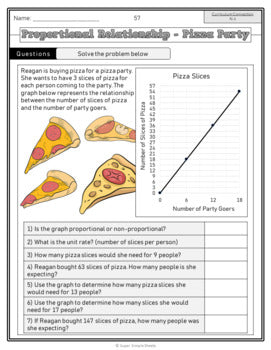BC Grade 8 Math Full Year Bundle
BC Grade 8 Math Full Year Bundle
Interested in a bundle? Shop below instead!
Couldn't load pickup availability
Distance Learning made easy! GOOGLE CLASSROOM VERSION - PDF INCLUDED! This gives you the ability to print worksheets as well as distribute a digital copy of the resource to your students on Google Classroom.
CHECK OUT THE PREVIEW TO SEE WHAT IS INCLUDED:
Grade 8 – British Columbia Math Curriculum – This resource covers all elaborations in the Grade 8 – British Columbia (BC) Redesigned Math Curriculum. There are 843 activity sheets for your students to learn and practice the elaborations in the curriculum. Using this resource will ensure that your students will be learning the new redesigned BC curriculum.
Numbers-
Concepts that are covered:
- Perfect squares and square roots
- Estimating square roots of numbers that are not perfect squares
- Visuals of square roots/perfect squares – area and number lines
- Converting fractions, decimal numbers, and percents
- Understanding percents greater than 100
- Understanding percents less than 1 (percentages in decimals)
- Rate and ratio
- Equivalent rates
- Identifying proportional and non-proportional relationships in various situations.
- Determining the value of a missing value in a ratio
- Converting mixed numbers and improper fractions
- Simplifying fractions
- Adding, subtracting, multiplying and dividing fractions using models and rules
- Multiplying fractions using repeated addition and number lines
- Word problems for all basic concepts for students to apply their understanding
- 3 Unit Tests
Patterns and Equations-
Some of the concepts that are covered:
- Basics of linear relationships (two-variable relations)
- Writing expressions that represents patterns
- Identifying linear relationships displayed as graphs and in tables of values
- Creating tables of values that represent patterns
- Creating graphs from tables of values (scale values)
- Graphing linear patterns using four quadrants
- Determining linear equations that represent patterns
- Representing linear equations using ordered pairs
- Graphing ordered pairs to display linear equations
- Determining the missing values in ordered pairs based on linear equations and pictorial patterns
- Solving problems arising in real-life situations using linear equations
- Expressions vs equations (difference between expressions vs equations)
- Evaluating expressions using substitution
- Solving two-step equations
- Solving expressions and equations using negative integers
- Modelling the preservation of equality (balance beams, diagrams, algebra tiles)
- 2 Unit Tests – 1 for each strand: Patterns and Equations
Geometry and Measurement-
Some of the concepts that are covered:
- Determine the surface area of rectangular prisms, triangular prisms and cylinders
- Use nets to calculate the surface area of 3D objects
- Calculate the area of circles and semi-circles
- Calculate the volume of rectangular prisms, triangular prisms, and cylinders
- Use the area of the base of 3D objects to calculate volume
- Use the Pythagorean theorem to determine if a triangle is a right triangle
- Use the Pythagorean theorem to calculate the length of a side on a right triangle
- Draw 3D objects using nets
- Construct nets that represent 3D objects
- Represent 3D objects by drawing them as nets on a grid
- Drawing top, front, and side views of objects
- Draw objects using top, front, and side views of objects
- Create 3D objects using top, front, and side views
- Isometric drawings of 3D objects
- Cavalier and cabinet drawings
- Perspective drawings using one-point perspectives and multiple vanishing points
Graphing and Probability-
Some of the concepts that are covered:
- Determining the mean, median, mode, and range of multiple data sets
- Finding the missing data point in a data set using the mean
- Determining outliers in a data set and explaining what outliers could represent
- Determining the effect of outliers in data sets on the mean, median and mode
- Understanding when to use each measure of central tendency to report findings
- Interpreting bar graphs, broken-line graphs, multiple-bar graphs, and circles graphs
- Creating bar graphs, broken-line graphs, and circle graphs
- Drawing conclusions about different sets of data
- Determining the mean, median, and mode from data presented in tables and graphs
- Thinking critically about misleading graphs
- Using fractions, decimals, and percents to represent the probability of multiple independent events
- Understanding the difference between theoretical and experimental probability
- Identifying the sample space (number of total outcomes) for experiments involving two independent events
- Comparing theoretical and experimental probabilities of independent and dependent events
- Using tree diagrams to represent independent events
- Using Venn diagrams to solve probability problems
Financial Literacy-
Some of the concepts that are covered:
- Unit Rates - Intro
- Unit Rates – Word Problems
- Equivalent Fractions
- Comparing Unit Rates
- Unit Rates – Best Buys
- Unit Price – Price Per 100
- Choosing a Service Rate
- Customer Loyalty and Incentive Programs
- Evaluating Customer Loyalty Programs
- Research – Customer Loyalty Programs
- Buying Second-Hand
- Choosing A Credit Card
- Researching Credit Cards
- Creating Credit Card Offers - Assignment
- Consumer Contracts
- Research - Cell Phone Plans
- Coupon Codes
- Coupons – Word Problems
- Financial Literacy – Unit Test
***Answer Pages for all worksheets are included
Share






A great resource to have to differentiate math instruction for grade 8 learners. The instructions are clear and the students like using them.









